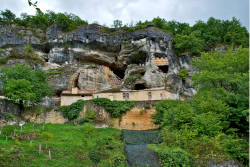Maison Forte de Reignac
Useful Information
| Location: |
Near Lespinasse, on the road between Tursac and Le Moustier.
At the shores of the Vezere river.
(44.979683, 1.054925) |
| Open: |
MAR to APR daily 10-18. MAY to JUN daily 10-19. JUL to AUG daily 10-20. SEP daily 10-20. OCT to 11-NOV daily 10-18. [2011] |
| Fee: |
Adults EUR 7, Children (5-13) EUR 3.50, Children (0-4) free, Students EUR 6. Groups (+): Adults EUR 6, Children (5-13) EUR 2.90, Students EUR 5. [2011] |
| Classification: |
 Cave Castle Cave Castle
 Cave House Cave House
|
| Light: |
 Incandescent Incandescent
|
| Dimension: | |
| Guided tours: | self guided. |
| Photography: | |
| Accessibility: | |
| Bibliography: | |
| Address: | Maison Forte de Reignac, Reignac, 24620 Tursac, Tel: +33-553-506954. |
| As far as we know this information was accurate when it was published (see years in brackets), but may have changed since then. Please check rates and details directly with the companies in question if you need more recent info. |
|
History
| 14th century | front wall built. |
| 1508 | windows added to the front wall. |
Description

The Maison Forte de Reignac (Fortified House of Reignac) is a Medieval cave castle. It was erected in the 14th century by fortifying the cliff shelter with a wall. Later the wall was changed by adding some windows.
In the early times the stronghold was the center of an estate with the right to low and high justice.
Later the low and high justice was transferred to the Lord of nearby
 Roque St Christophe.
The fortification was intended as protection against outlaws and bandits.
It was not a military fortification which could resist an army.
But the strategic location allowed attacks only from the front, which was protected by 12 guns.
The elevated location made attacks hard and allowed to throw rocks and hot liquids on the attackers.
Roque St Christophe.
The fortification was intended as protection against outlaws and bandits.
It was not a military fortification which could resist an army.
But the strategic location allowed attacks only from the front, which was protected by 12 guns.
The elevated location made attacks hard and allowed to throw rocks and hot liquids on the attackers.
Today the fortified house is completely renovated and is a museum of the Middle Ages. Several rooms are equipped with original furniture, and there is an exhibition of torture instruments. There is also a typical Medieval curio cabinet with minerals, stuffed animals, curiosities, and artifacts.
 Search DuckDuckGo for "Maison Forte de Reignac"
Search DuckDuckGo for "Maison Forte de Reignac" Google Earth Placemark
Google Earth Placemark Maison Forte de Reignac, official website (visited: 02-APR-2011)
Maison Forte de Reignac, official website (visited: 02-APR-2011) Index
Index Topics
Topics Hierarchical
Hierarchical Countries
Countries Maps
Maps